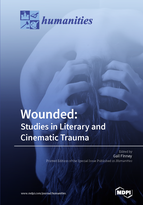Wounded: Studies in Literary and Cinematic Trauma
A special issue of Humanities (ISSN 2076-0787).
Deadline for manuscript submissions: closed (1 September 2017) | Viewed by 62293
Special Issue Editor
Interests: psychoanalysis and literature/film, especially trauma theory; turn of-the-century european drama and culture; modern drama; the nineteenth-century european novel; feminism
Special Issue Information
Dear Colleagues,
We live in an era of traumatic discourse. The wound (trauma is the Greek word for “wound”) speaks multiple languages. Often the trauma registered is political—the trauma of war in Syria, Afghanistan, Iraq, and other nations and the concomitant European migrant crisis. Literature and films about Hiroshima, Vietnam, 9/11, and, perhaps above all, the Holocaust, abound. We encounter memoirs of survivors, and now memoirs of the children of survivors, in connection with whom Marianne Hirsch has coined the term “postmemory.” Furthermore, the recent series of brutal and unjust actions toward unarmed blacks by white law officers is generating a new discourse of the long-standing trauma of race relations in the United States.
Autobiographical and other narratives of family trauma are also flourishing. Memoirs by the dozen seek to come to terms with childhood and youthful experiences scarred by radical alienation between family members, extreme poverty, addictions of all kinds, child and spousal abuse, child molestation and parent-child incest, sibling incest, divorce, suicide, and murder.
Traumatic experience is frequently rendered in fantastic terms, as in the manifold science fiction and horror representations of vampires, zombies, ghosts, and interstellar travelers, which can be read as displaced manifestations of post 9/11 paranoia or of a generalized culture of trauma.
This Special Issue, therefore, invites new approaches to the study of collective or individual trauma as presented in literature or film. All national traditions are welcomed.
Deadline for Proposal Submissions: 1 February 2017
Deadline for completed papers, if selected (5000–7000 words): 1 September, 2017
Humanities, an international, scholarly, open access journal, and its Guest Editor, Professor Gail Finney, are seeking proposals for a Special Issue focused on “Literary and Cinematic Trauma.”
Submit 250–500 word proposals for original contributions and a 100-word biography (include selected publications) by 1 February 2017; please email both the Guest Editor, as indicated above, and the journal ([email protected]).
Prof. Dr. Gail Finney
Guest Editor
Manuscript Submission Information
Manuscripts should be submitted online at www.mdpi.com by registering and logging in to this website. Once you are registered, click here to go to the submission form. Manuscripts can be submitted until the deadline. All papers will be peer-reviewed. Accepted papers will be published continuously in the journal (as soon as accepted) and will be listed together on the special issue website. Research articles, review articles as well as short communications are invited. For planned papers, a title and short abstract (about 100 words) can be sent to the Editorial Office for announcement on this website.
Submitted manuscripts should not have been published previously, nor be under consideration for publication elsewhere (except conference proceedings papers). All manuscripts are thoroughly refereed through a double-blind peer-review process. A guide for authors and other relevant information for submission of manuscripts is available on the Instructions for Authors page. Humanities is an international peer-reviewed open access semimonthly journal published by MDPI.
Please visit the Instructions for Authors page before submitting a manuscript. Submitted papers should be well formatted and use good English. Authors may use MDPI's English editing service prior to publication or during author revisions.
Keywords
- Trauma
- War
- Severe family dysfunction
- Holocaust
- Postmemory
- Racial strife
- Trauma and the Fantastic, e.g., Zombies






